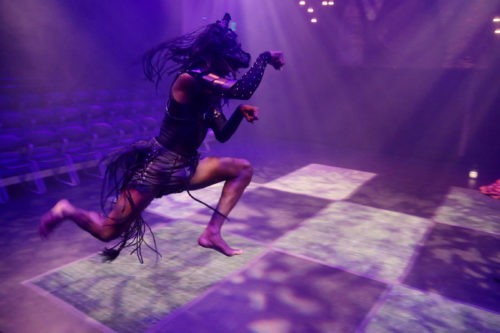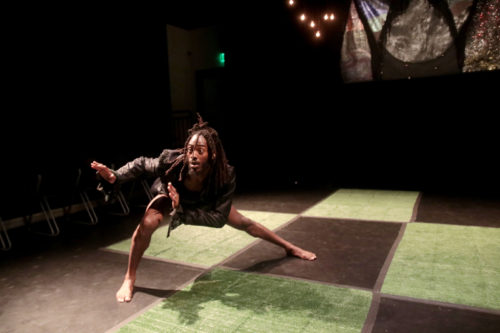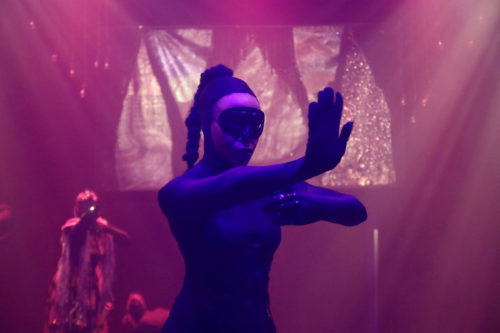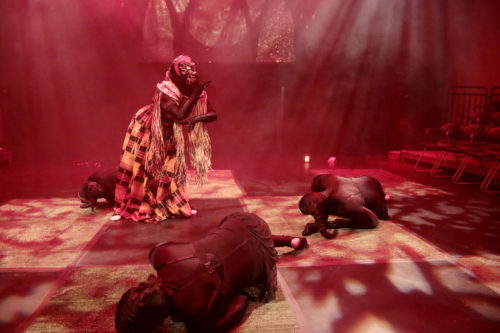Delving Into History In Order To Move Forward
Delving Into History In Order To Move Forward: the unnamed three’s Hatch, and Brother(hood) Dance’s HAWA (The Ride), in collaboration with the Pilot Dance Project
I will not have my life narrowed down. I will not bow down to somebody else’s whim or to someone else’s ignorance.—Bell Hooks
If I didn’t define myself for myself, I would be crunched into other people’s fantasies for me and eaten alive.—Audre Lorde

All photos by Pin Lim
The Pilot Dance Project hosted a panel discussion on contemporary Black dance and queer narratives in order to provide the Houston queer, dance, and arts communities with a proper introduction to Brother(hood) Dance!, their collaborator for their Spring concert, titled HAWA (The Ride). The panel, which was moderated by Adam Castaneda, the Executive Director of the Pilot Dance Project, featured Orlando Hunter, who co-directs (with Ricarrdo Valentine) Brother(hood) Dance!, a collective that researches, creates, and performs dances of freedom in order to inform its audiences on the sociopolitical and environmental injustices from a global perspective, bringing clarity to the same-gender-loving African-American experience in the 21st century. The panel, which also featured intriguing conversation around queerness and art with speakers Byron Canady (SWAMP), Harrison Guy (Urban Souls Dance Company), Kristian Salinas (QFest), and Stephanie Saint Sanchez (Seniorita Cinema), offered an enriching investigation of Brother(hood) Dance!’s work as a whole and an introduction to some of the concepts that were explored in HAWA: The Ride. In particular, however, Orlando Hunter offered a few statements that evening that provide a compelling framework with which to consider the entire evening, which also included the opening number Hatch, by the unnamed three, choreographed by queer artist Andrés Renteria and performed by Black dancers Kaeleb Edwards and Ty Lewis: What does it mean to choreograph as liberation? Can we look back in order to create a future? How can we take the negative imprint on the world and shift the energy towards healing?
Hatch opened to a pitch-black stage. As a female-presenting digitized voice delivered various dictionary definitions of the word feminine, two Black dancers in identical costumes of a blue tank top, black Adidas leggings, and bare feet, walked on stage. As a soft light enveloped the stage, Ty Lewis held Kaeleb Edwards with slight difficulty, his torso wrapped horizontally around hers. After she gradually drops Edwards to the floor, the two dancers begin to move—at times in unison, at times individually responding to the music as though they were at a house disco, to various house mixes interspersed with the elevation of Black femme singers such as Gloria Gaynor and Beyoncé, as well as vocal clips from the ballroom documentary, Paris is Burning.
Although I appreciated the spotlight on Black queer sexuality with the references to voguing culture and the exploration of gender, the ideas ultimately fell a little short of execution in terms of the movement and the aesthetic. I couldn’t take my eyes off of Lewis, whose movements were dynamic, and had a kind of primal engagement with the self. That being said, her performance felt confidently feminine in terms of the suppleness of the body, the loosening of the hips, and the drawing into one’s own interior/exterior expression. Edwards, on the other hand, who I felt was at a bit more of a remove in comparison, felt a bit stiffer with his expression, and therefore, more what we would expect with regards to a masculine dancer. If the aesthetic of the costumes, or the execution of the dancers in relationship to their apparent gender identity, had explored more possibilities with how one questions the gender binary in the movement and appearance of the performers, then the choreography would have complicated what seemed to be the ultimate interrogation for the piece, as when, a male-presenting voice asks: So what’s more in you? Feminine or masculine? Ultimately, I was incredibly drawn to the improvisation framework of the piece and how it highlighted Black femme and queer histories, and although I found much to admire regarding the quality of the movement itself, I yearned for more cohesion between the ideas presented in the recorded text and musical references and the choreography itself.
HAWA (The Ride) is a narrative work centering non-European diasporic dance forms and seeks to explore Black jockeys, the unsung heroes of America’s first professional sport. Hawa, a word that originally comes from Arabic, is an African feminine name derived from Eve. The title is an important frame to begin to witness this potent world loaded with historical significance and cultural signifiers, because as Hunter has said, he explicitly centers femme voices and forms in both the conceptualization and choreographic execution of his work. But as we will see, the interrogation and exploration of the feminine in this work is multi-layered.
 The piece opens with a lantern floating in blackness. Images of jockeys are projected onto a tapestry backdrop designed by Black visual artist Christa Pratt. The black tapestry includes images that represent I95, the longest north-to-south interstate, scarification of the body that includes hair from Hunter’s head, and a glittering abyss. While images are projected, a voice can be heard saying, There are two jockeys on the lawn at all times. The legend of each jockey varies from how they actually got to be horsemen. Some say Jocko was a spirit that died holding a lantern waiting for Jefferson to come back from the war in the winter. Jefferson deemed this act so noble he had them bring his spirit back. So Jocko stands there, lantern in hand, waiting, watching, waiting. Some of the images include figurines with faces and bodies so black that you imagine could end up in the wrong hands—it’s a clever move to use the image to indicate the difficult questions of appropriation and the long scarred history of racial consumption by white supremacy before it is indicated in the movement itself.
The piece opens with a lantern floating in blackness. Images of jockeys are projected onto a tapestry backdrop designed by Black visual artist Christa Pratt. The black tapestry includes images that represent I95, the longest north-to-south interstate, scarification of the body that includes hair from Hunter’s head, and a glittering abyss. While images are projected, a voice can be heard saying, There are two jockeys on the lawn at all times. The legend of each jockey varies from how they actually got to be horsemen. Some say Jocko was a spirit that died holding a lantern waiting for Jefferson to come back from the war in the winter. Jefferson deemed this act so noble he had them bring his spirit back. So Jocko stands there, lantern in hand, waiting, watching, waiting. Some of the images include figurines with faces and bodies so black that you imagine could end up in the wrong hands—it’s a clever move to use the image to indicate the difficult questions of appropriation and the long scarred history of racial consumption by white supremacy before it is indicated in the movement itself.
Jocko (performed by Hunter) enters holding a lantern, dressed all in black—fitted top, shorts, and a formal jacket, while wearing a bedazzled mask that hides only the top half of his face. A voiceover accompanies him: Two jockeys are on the lawn at all time. The legend of each jockey varies on how they actually got to be horsemen. Some say Cavalier spirit got the job next to Jocko because the boss needed more light. As Jefferson and Franklin rode past Jocko and Cavalier spirit, Jocko overhears Jefferson talking about the legend of Queen Amina. The projection changes from images of the jockeys to those of Jefferson and Franklin, as well as Michelle Obama. The lights flash while the audience hears whispering voices evoke the name of Queen Amina.
For a brief moment, Ginuwine’s Pony plays on the speaker before landing on The Last Poets’ Tribute to Obabi. Not only is the small clip a sign of Jocko’s final solo, but it also cleverly offers some levity, connecting Black sports histories to Black popular cultural currencies. There’s a through-line here underneath the surface—in considering the long history of the Black male body as sexually potent, objectified by the white public, the incorporation of that small moment of a song with which a modern audience is most undoubtedly familiar, the tiny sonic taste of Pony in this opening number is a kind of knowing wink to the audience of the ways in which a sexualized athletic Black body has been used as commodity.
Jocko throws the mask off of his face, and performs a powerful opening solo, evoking stylized movements signifying the jockey. Hunter’s movements reference various African diasporic dance lineages, such as those stemming from Haiti, Trinidad, Guinea, and Jamaica. Although Hunter is both man—his wide legged stance signifying both the African pose as well as that of a man riding his horse—and horse—at times performing movements that resonate with the trot or gallop of a horse, slapping one leg or the other as though it were the horse’s torso, it’s still early and he is more man at this point than horse.
Jocko’s movements become more free and embracing, taking up more and more space on the stage. As he begins to move with abandon, prancing around the stage while the horse neighs in the background, Jocko’s solo and joy are cut short by the wails (and lights) of a siren. The siren, and Jocko’s response to it, offers a layered exploration of the ways in which Black lives have been erased, both then and now, in the oppressive lands of American soil. One cannot help but think of Jocko in this moment in contemporary American society, in which a siren for any Black American means the potential of another Black life to be taken at the hands of (dominantly) white male police officers. It’s a compelling and sobering moment so early in the piece, and powerfully reflects on the ways in which Black joy has been, quite literally, policed at the hands of white power.
 As Jocko exits, three figures dressed from head to foot in black, including the face, appear on the floor on their sides, while an androgynous figure (performed by Ashley Horn) representing the patriarchy hovers over them. They wear a costume of traditional African fabric, including a wide skirt and a mask which covers the entire face. The body of the piece centers the patriarchal figure and their three henchmen (Adam Castaneda, Ayan Felix, and Tory Pierce). The movement extends beyond African diasporic dance forms and also explores movement from contemporary Indian yorrcha, Voguing, Bucking, and Majorette lineages. At times the three henchmen figures dance in unison with the patriarchal figure, and at times they move on their own, while the patriarchal figure hovers over them. Just as in contemporary American society, there are moments of rebellion within feeling surveilled and controlled by white supremacy, which are movingly portrayed by Ayan Felix’s solo relishing in her own self pleasure and the ensemble voguing number. Although I was incredibly moved by the complex choreographies and what they signified against the patriarchal figure, Orlando Hunter’s facility with those movement vocabularies very clearly stood out against the performances of the other dancers. Horn’s movements as the patriarchal figure were effective in coming across as looming and menacing, but didn’t feel like an appropriate match to Hunter’s stunning physicality and grounded but precise footwork.
As Jocko exits, three figures dressed from head to foot in black, including the face, appear on the floor on their sides, while an androgynous figure (performed by Ashley Horn) representing the patriarchy hovers over them. They wear a costume of traditional African fabric, including a wide skirt and a mask which covers the entire face. The body of the piece centers the patriarchal figure and their three henchmen (Adam Castaneda, Ayan Felix, and Tory Pierce). The movement extends beyond African diasporic dance forms and also explores movement from contemporary Indian yorrcha, Voguing, Bucking, and Majorette lineages. At times the three henchmen figures dance in unison with the patriarchal figure, and at times they move on their own, while the patriarchal figure hovers over them. Just as in contemporary American society, there are moments of rebellion within feeling surveilled and controlled by white supremacy, which are movingly portrayed by Ayan Felix’s solo relishing in her own self pleasure and the ensemble voguing number. Although I was incredibly moved by the complex choreographies and what they signified against the patriarchal figure, Orlando Hunter’s facility with those movement vocabularies very clearly stood out against the performances of the other dancers. Horn’s movements as the patriarchal figure were effective in coming across as looming and menacing, but didn’t feel like an appropriate match to Hunter’s stunning physicality and grounded but precise footwork.
In the final section of the piece, the henchmen unmask and disrobe the patriarchal figure, who is revealed to be a white blonde woman. This is a brilliant reconfiguration of how white supremacy operates in American culture, and immediately brought to mind the ways in which white femininity is weaponized against bodies of color, or the ways in which white women use their privilege to move away from victimized women in support of powerful white men. The piece closes with a final solo from Hunter, after the other dancers adorn him with accessories that merge the line between fetishwear and accouterments signaling Jocko’s transformation to a horse spirit, including detached black sleeves, shoulder pieces that also remind me of a saddle, and a headpiece resembling a horse head.
 There is a kind of ritualized ceremony given to the dressing of Jocko’s final moment of the piece, and offers a deep contrast to the black costume that is revealed when the other dancers undress the patriarchal figure and remove her source of power. Even as the patriarchal figure is disrobed, she is still dressed in the ideology (and appropriative power) of blackness, whereas Jocko is adding on more signifiers of his own history, his own skin. Ginuwine’s Pony returns in full in Hunter’s final solo, and his movements transition from horse-like movements to an exploration of the limitlessness of his eroticized body. Except this time, it is not for the audience—it’s for his own embodied connection with himself as he ultimately moves on, we imagine, to find Queen Amina in the spiritworld.
There is a kind of ritualized ceremony given to the dressing of Jocko’s final moment of the piece, and offers a deep contrast to the black costume that is revealed when the other dancers undress the patriarchal figure and remove her source of power. Even as the patriarchal figure is disrobed, she is still dressed in the ideology (and appropriative power) of blackness, whereas Jocko is adding on more signifiers of his own history, his own skin. Ginuwine’s Pony returns in full in Hunter’s final solo, and his movements transition from horse-like movements to an exploration of the limitlessness of his eroticized body. Except this time, it is not for the audience—it’s for his own embodied connection with himself as he ultimately moves on, we imagine, to find Queen Amina in the spiritworld.
HAWA (The Ride) was a brilliant tribute to Black jockeys while also interrogating contemporary issues of race, appropriation, ritual, and Black sexuality. Not only did it delve into Black American history through the narrative frame, HAWA also elevated non-European diasporic dance forms, both American and global. In other words, not only did the piece tell the stories of the unsung heroes of Black American culture, it offered a movement narrative outside of the white-centered traditions that dominate so much of American concert dance. Although it was clear that the spirit of Queen Amina floated in the world of HAWA (The Ride), I would love to see more attention given to this Nigerian warrior queen, particularly in stark contrast to the feminine patriarchal figure. I strongly hope that Brother(hood) Dance! extends this piece into a full-length work so that these ideas can receive a more extensive exploration.



Recent Comments